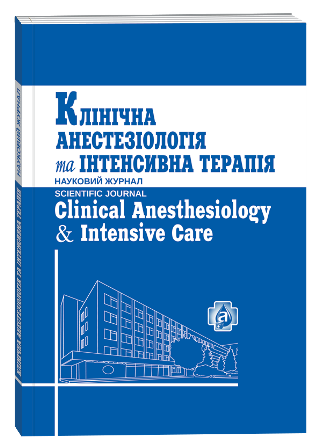CHANGES OF ARTERIAL BLOOD PRESSURE AND HEART RATE DURING INDUCTION OF ANESTHESIA WITH MIDAZOLAM AND FENTANYL. IS ENHANCED BASAL CARDIAC PARASYMPATHETIC TONUS A RISK FACTOR FOR CARDIOVASCULAR INSTABILITY?
DOI:
https://doi.org/10.31379/2411.2616.13.1.3Keywords:
arterial hypotension, sinus bradycardia, cardiac parasympathetic tonusAbstract
Background. Induction of general anesthesia with midazolam and fentanyl is frequently associated with changes in arterial blood pressure and heart rate. At present, there are no clinical studies investigating the relation between basal cardiac autonomic tonus and cardiovascular instability after induction of general anesthesia with midazolam and fentanyl. The aim of the study was to evaluate the changes of arterial blood pressure and heart rate after induction of general anesthesia with midazolam and fentanyl and to determine if a relationship exists between basal cardiac autonomic tonus and hemodynamic instability. Materials and methods. A randomized prospective study was performed with approval of Ethic Committee. Written informed consent was obtained from all patients. We enrolled in the study 47 ASA physical status I–II patients scheduled for elective surgical procedures. Heart rate variability by Holter ECG, arterial blood pressure (systolic, diastolic, mean), and heart rate were measured at baseline, after premedication, as well as after induction of general anesthesia with midazolam 0.2- 0.3 mg/kg and fentanyl 1.5 mkg/kg Results of the research. Induction of general anesthesia with midazolam and fentanyl was associated with an increase in cardiac parasympathetic tonus. Our research revealed that increased basal cardiac parasympathetic tonus was a risk factor for development of sinus bradycardia (OR = 13.1 (95%CI 3.1-54.7, p=0.0002) and arterial hypotension (OR = 12.7 (95%CI 2.9 -55.9, p=0.0003). Conclusions. Induction of general anesthesia with midazolam and fentanyl was associated with arterial hypotension and sinus bradycardia. Increased basal cardiac parasympathetic tonus represents a risk factor for development of arterial hypotension and sinus bradycardia after administration of midazolam and fentanyl for induction of general anesthesia.
References
Intranasal fentanyl, midazolam and dexmedetomidine as premedication in pediatric patients. / V. Chatrath [et al.] // Anesth Essays Res. – 2018. – Vol. 2(3). – P. 748-753.
Prabhudev, A.M., Chogtu, B., Magazine, R. Comparison of midazolam with fentanyl-midazolam combination during flexible bronchoscopy: A randomized, double-blind, placebo-controlled study. / A.M. Prabhudev, B. Chogtu, R. Magazine // Indian J Pharmacol. – 2017. – Vol. 49(4). – P. 304–311.
Comparing two different doses of intravenous midazolam in pediatric sedation and analgesia. / H Barzegari [et al.] // Emergency. – 2016. – Vol. 6(4). – P. 192-195.
Novel positive allosteric modulators of GABA-A receptors with anesthetic activity. / M.C. Maldifassi [et al.] // Sci Rep. – 2016. – Vol. 6 (25943). doi:10.1038/srep25943.
A comparison of propofol and midazolam/meperidine sedation in upper gastrointestinal endoscopy. / S. Uzman [et al.] // Wideochir Inne Tech Maloinwazyjne. – 2016. – Vol. 11(3). – P. 178–185.
Propofol versus midazolam for upper gastrointestinal endoscopy in cirrhotic patients: a metaanalysis of randomized controlled trials. / H.C. Tsai [et al.] // PLoS One. – 2015. – Vol. 10(2). e0117585.
Zhang, R., Lu, Q., Wu, Y. The comparison of midazolam and propofol in gastrointestinal endoscopy: A systematic review and meta-analysis. / R. Zhang, Q. Lu, Y. Wu // Surg Laparosc Endosc Percutan Tech. – 2018. – Vol. 28(3). – P. 153-158.
Dexmedetomidine versus midazolam for conscious sedation in postoperative patients undergoing flexible bronchoscopy: a randomized study. / W. Liao [et al.] // J Int Med Res. – 2012. – Vol. 40(4). – P. 1371-1380.
Co‑induction effects of midazolam, thiopentone and ketamine with propofol in general anesthesia. / G. Rajkumar [et al.] // J Med Soc. – 2013. – Vol. 27(2). – P. 110-113.
Comparison of sufentanil-midazolam and sevoflurane for anesthesia induction in children undergoing cardiac surgery by real-time hemodynamic and cardiac efficiency monitoring: A prospective randomized study. / D. Han [et al.] // Heart Surg Forum. – 2019. – Vol. 22(1). – E038-E044.
Hemodynamic characteristics of midazolam, propofol, and dexmedetomidine in healthy volunteers. / M.A. Frölich [et al.] // J Clin Anesth. – 2011. – Vol. 23(3). – P. 218-223.
Choi, Y.F., Wong, T.W., Lau, C.C. Midazolam is more likely to cause hypotension than etomidate in emergency department rapid sequence intubation. / Y.F. Choi, T.W. Wong, C.C. Lau // Emerg Med J. – 2004. – Vol. 21(6). – P. 700–702.
Anderson, T. Heart rate variability: implications for perioperative anesthesia care. / T. Anderson // Curr Opin Anaesthesiol. – 2017. – Vol. 30(6). – P. 691–697.
HRV analysis: A free software for analyzing cardiac autonomic activity. / V. Pichot [et al.] //Front Physiol. – 2016. – Vol. 22(7). – P. 557.
Nishiyama, T. Effects of premedication on heart rate variability at induction of anaesthesia: comparison between midazolam and hydroxyzine. / T. Nishiyama // Turk J Anaesthesiol Reanim. – 2018. – Vol. 46(3). – P. 229–232.
Smith, A., Owen, H., Reynolds, K. Can short-term heart rate variability be used to monitor fentanyl-midazolam induced changes in ANS preceding respiratory depression? / A. Smith, H. Owen, K. Reynolds // J Clin Monit Comput. – 2015. – Vol. 29(3). – P. 393–405.
The effect of sedation during transoesophageal echocardiography on heart rate variability: a comparison of hypnotic sedation with medical sedation. / Y. Dogan [et al.] // Kardiol Pol. – 2016. – Vol. 74(6). – P. 591–597.
Changes of vegetative heart tonus after induction of general anesthesia with midazolam and fentanyl. / I. Feghiu [et al.] // Clin Anesth Int Care. – 2018. – Vol. 2(12). – P. 15-23.
Heart rate variability: standards of measurement, physiological interpretation and clinical use. / Task Force of the European Society of Cardiology and the North American Society of Pacing and Electrophysiology. // Circulation. – 1996. – Vol. 93(5). – P. 1043–1065.
Rahman, N.H., Hashim, A. Is it safe to use propofol in the emergency department? A randomized controlled trial to compare propofol and midazolam. / N.H. Rahman, A. Hashim // Int J Emerg Med. – 2010. – Vol. 3(2). – P. 105–113.







